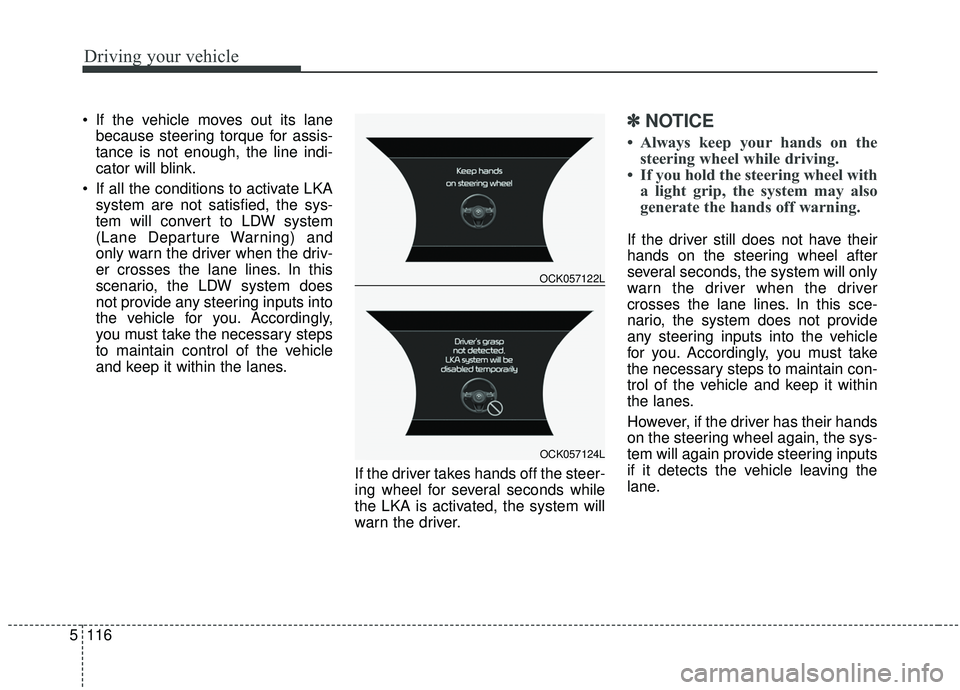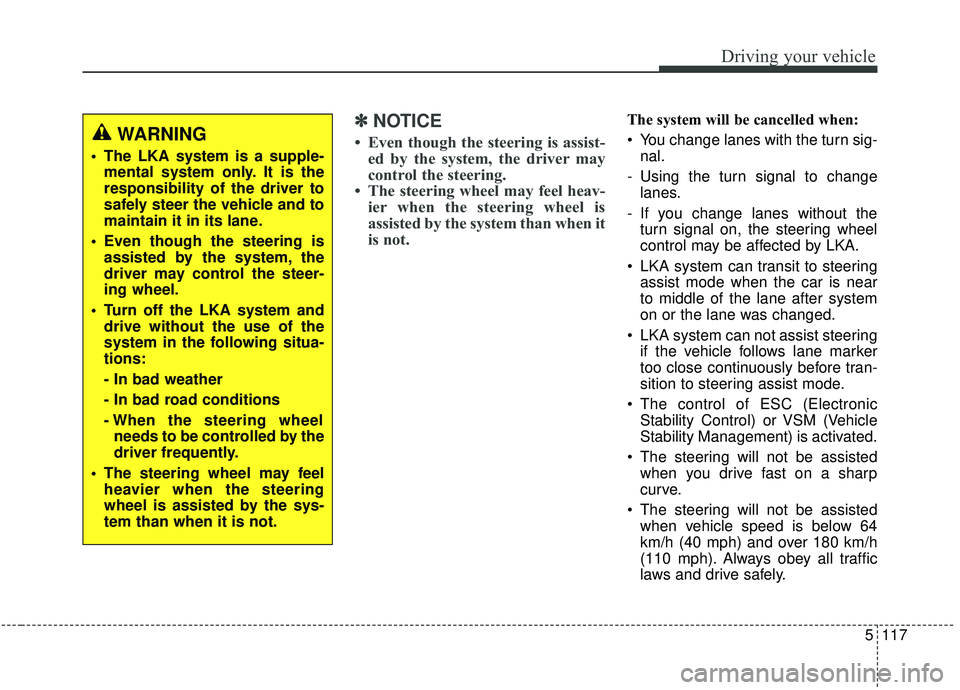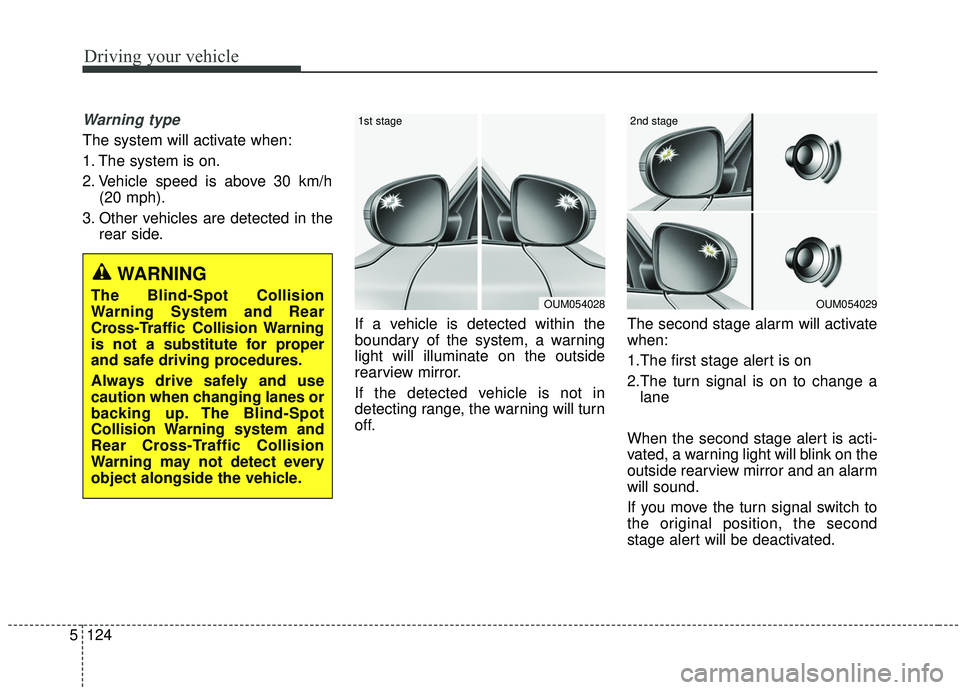Page 369 of 555

Driving your vehicle
116
5
If the vehicle moves out its lane
because steering torque for assis-
tance is not enough, the line indi-
cator will blink.
If all the conditions to activate LKA system are not satisfied, the sys-
tem will convert to LDW system
(Lane Departure Warning) and
only warn the driver when the driv-
er crosses the lane lines. In this
scenario, the LDW system does
not provide any steering inputs into
the vehicle for you. Accordingly,
you must take the necessary steps
to maintain control of the vehicle
and keep it within the lanes.
If the driver takes hands off the steer-
ing wheel for several seconds while
the LKA is activated, the system will
warn the driver.✽ ✽
NOTICE
• Always keep your hands on the
steering wheel while driving.
• If you hold the steering wheel with a light grip, the system may also
generate the hands off warning.
If the driver still does not have their
hands on the steering wheel after
several seconds, the system will only
warn the driver when the driver
crosses the lane lines. In this sce-
nario, the system does not provide
any steering inputs into the vehicle
for you. Accordingly, you must take
the necessary steps to maintain con-
trol of the vehicle and keep it within
the lanes.
However, if the driver has their hands
on the steering wheel again, the sys-
tem will again provide steering inputs
if it detects the vehicle leaving the
lane.
OCK057122L
OCK057124L
Page 370 of 555

5117
Driving your vehicle
✽ ✽
NOTICE
• Even though the steering is assist-
ed by the system, the driver may
control the steering.
• The steering wheel may feel heav- ier when the steering wheel is
assisted by the system than when it
is not.
The system will be cancelled when:
You change lanes with the turn sig-
nal.
- Using the turn signal to change lanes.
- If you change lanes without the turn signal on, the steering wheel
control may be affected by LKA.
LKA system can transit to steering assist mode when the car is near
to middle of the lane after system
on or the lane was changed.
LKA system can not assist steering if the vehicle follows lane marker
too close continuously before tran-
sition to steering assist mode.
The control of ESC (Electronic Stability Control) or VSM (Vehicle
Stability Management) is activated.
The steering will not be assisted when you drive fast on a sharp
curve.
The steering will not be assisted when vehicle speed is below 64
km/h (40 mph) and over 180 km/h
(110 mph). Always obey all traffic
laws and drive safely.
WARNING
The LKA system is a supple-mental system only. It is the
responsibility of the driver to
safely steer the vehicle and to
maintain it in its lane.
Even though the steering is assisted by the system, the
driver may control the steer-
ing wheel.
Turn off the LKA system and drive without the use of the
system in the following situa-
tions:
- In bad weather
- In bad road conditions
- When the steering wheelneeds to be controlled by the
driver frequently.
The steering wheel may feel heavier when the steering
wheel is assisted by the sys-
tem than when it is not.
Page 372 of 555

5119
Driving your vehicle
�When external condition is inter-
vened
- The brightness of outside changes suddenly when entering/exiting a
tunnel or passing under a bridge.
- The headlamps are not on at night or in a tunnel, or light level is low.
- There is a boundary structure in the roadway.
- The light reflects from water on the road.
- When light shines brightly from behind the vehicle.
- The distance from the vehicle ahead is very short or the vehicle
ahead covers up the lane line.
- You drive on a steep grade or a sharp curve.
- The vehicle vibrates heavily.
- The temperature near inside mirror is very high due to direct sun light
and etc. �
When front visibility is poor
- The lens or windshield is covered by foreign materials.
- The sensor cannot detect the lane because of fog, heavy rain or snow.
- The windshield is fogged by humid air in the vehicle.
- There is an object on the dash- board that interferes with the cam-
era.LKA system malfunction
If there is a problem with the system
a message will appear. If the problem
continues the LKA system fail indica-
tor will illuminate.
OCK057126LWARNING
The Lane Keeping Assist sys-
tem is a system to help prevent
the driver from leaving the lane.
However, the driver should not
solely rely on the system but
always take the necessary
actions for safe driving prac-
tices.
Page 373 of 555

Driving your vehicle
120
5
LKA system fail indicator
The LKA system fail indicator (yel-
low) will illuminate with an audible
warning if the LKA system is not
working properly. In this case, have
the system checked by an authorized
Kia dealer. When there is a problem with the sys-
tem do one of the following:
Turn the system on after turning
the engine off and on again.
Check if the ignition switch is in the ON position.
Check if the system is affected by the weather. (ex: fog, heavy rain,
etc.)
Check if there is foreign matter on the camera lens
If the problem is not solved, have the
system checked by an authorized
Kia dealer.
LKA system Function Change
The driver can change LKA to Lane
Departure Warning System (LDW
system) or change the LKA system
mode between Standard LKA and
Active LKA from the User Settings
Mode on the LCD display.
The driver can choose them by plac-
ing the ignition switch to the ON posi-
tion and by selecting ‘User Settings’,
‘Driver Assistance’, and ‘Lane
Keeping Assist’.
The system is automatically set to
Standard LKA.
Page 374 of 555
5121
Driving your vehicle
Lane Departure
LDW alerts the driver with a visual
and acoustic warning when the sys-
tem detects the vehicle leaving the
lane. In this mode, the system will not
provide steering inputs. When the
vehicle’s front wheel contacts the
inside edge of lane line, LKA system
issues the lane departure warning.
Standard LKA
The Standard LKA mode guides the
driver to keep the vehicle within the
lanes. It provides inputs to the steer-
ing when the vehicle is about to devi-
ate from the lanes.
Active LKA
The active inputs to the LKA mode
provides more frequent steering in
comparison with the Standard LKA
mode.
Page 375 of 555

Driving your vehicle
122
5
The Blind-Spot Collision Warning
(BCW) system uses radar sensors in
the rear bumper to monitor and warn
the driver of an approaching vehicle
in the driver's blind spot area.
The system monitors the rear area of
the vehicle and provides information
to the driver with an audible alert and
a indicator on the outside rearview
mirrors. (1) Blind spot area
The BCW range varies relative tovehicle speed. Note that if your
vehicle is traveling much faster
than the vehicles around you, the
warning will not occur.
(2) Closing at high speed The BCW-Closing at high speedfeature will alert you when it
detects a vehicle is approaching
in an adjacent lane at a high rate
of speed. If the driver activates
the turn signal when the system
detects an oncoming vehicle, the
system sounds an audible alert. (3) RCCW (Rear Cross-Traffic
Collision Warning)
The RCCW feature monitors approaching cross traffic from the
left and right side of the vehicle
when your vehicle is in reverse.
The feature will operate when the
vehicle is moving in reverse
below about 10 km/h (6 mph). If
oncoming cross traffic is detected
a warning chime will sound.
BLIND-SPOT COLLISION WARNING (BCW) (IF EQUIPPED)
OYG056141L
Page 376 of 555

5123
Driving your vehicle
BCW (Blind-Spot Collision
Warning)
Operating conditions
The indicator on the switch will illumi-
nate when the Blind-Spot Collision
Warning System (BCW) switch is
pressed with the engine start/stop
Button ON.
If vehicle speed exceeds 30 km/h
(20 mph), the system will activate.
If you press the switch again, the
switch indicator and system will be
turned off.
If the vehicle is turned off, the system
will remember the last settings upon
restart.When the system is not used turn the
system off by turning off the switch.
When the system is turned on the
warning light will illuminate for 3 sec-
onds on the outside rearview mirror.
OCK057049N
WARNING
- BCW Limitations
The Blind-Spot Collision Warning System (BCW) is a
supplemental system. Do not
solely rely on the system and
always pay attention to drive
safely.
The Blind-Spot Collision Warning System may not
detect every object alongside
the vehicle and is not a sub-
stitute for proper and safe
lane changing procedures.
Always drive safely and use
caution when changing lanes.
Page 377 of 555

Driving your vehicle
124
5
Warning type
The system will activate when:
1. The system is on.
2. Vehicle speed is above 30 km/h
(20 mph).
3. Other vehicles are detected in the rear side.
If a vehicle is detected within the
boundary of the system, a warning
light will illuminate on the outside
rearview mirror.
If the detected vehicle is not in
detecting range, the warning will turn
off. The second stage alarm will activate
when:
1.The first stage alert is on
2.The turn signal is on to change a
lane
When the second stage alert is acti-
vated, a warning light will blink on the
outside rearview mirror and an alarm
will sound.
If you move the turn signal switch to
the original position, the second
stage alert will be deactivated.
OUM054029
2nd stage
OUM054028
1st stage
WARNING
The Blind-Spot Collision
Warning System and Rear
Cross-Traffic Collision Warning
is not a substitute for proper
and safe driving procedures.
Always drive safely and use
caution when changing lanes or
backing up. The Blind-Spot
Collision Warning system and
Rear Cross-Traffic Collision
Warning may not detect every
object alongside the vehicle.